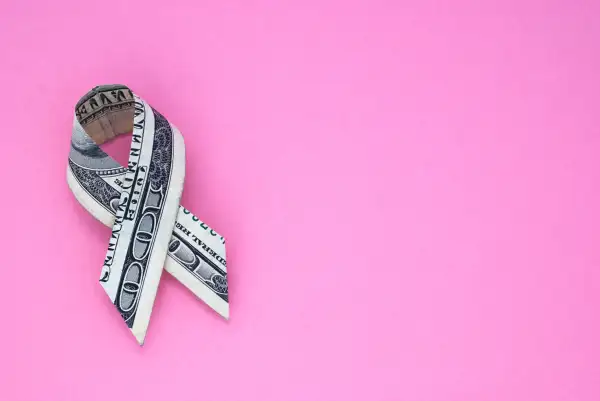How to Make the Biggest Impact With Your Breast Cancer Donations

October is Breast Cancer Awareness month, in case you hadn't noticed.
But how could you not? This time of year, pink ribbons and other paraphernalia—from buckets of chicken to NFL jerseys—have become more ubiquitous than pumpkins.
While buying those pink-ribbon products may seem like an easy way to support the 3 million people living with breast cancer in the U.S., you should think twice before purchasing.
Not everything with a pink ribbon is supporting research for a cure, says Gayle Sulik, author of Pink Ribbon Blues: How Breast Cancer Culture Undermines Women’s Health. Some of these products give no proceeds to cancer charities, but simply “raise awareness.”
Other times, Sulik adds, sales of the products don’t have any impact on a company's giving as the firm has already set a cap on its donation amount.
Even worse than buying a pink product that gives nothing back is buying a product from a company that “pinkwashes,” or promotes pink ribbon products while also selling or producing products that contain ingredients known to increase the risk of breast cancer.
All in all, “it doesn’t make much sense to buy pink ribbon products," says Samantha King, author of Pink Ribbons, Inc: Breast Cancer and the Politics of Philanthropy. “By doing so, you’re simply subsidizing corporate marketing campaigns. If you want to give, give directly to the breast cancer organization.”
Plus, by giving directly you get to report the tax-deductible charity contribution, rather than letting a corporation have your write-off, notes Sulik.
Of course, with all the different charities vying for your generosity, it can be overwhelming trying to figure out where exactly you should donate.
To make that task easier, Money—with the help of Sulik, King and Charity Navigator—identified five breast cancer charities where you can feel confident that your dollars will be put to good use funding prevention research, education, and patient support.
These organizations have high levels of accountability, have successfully sustained their programs over time, and spend a high percentage of their revenue on programs and services rather than administrative or fundraising costs.
If you want to support prevention research:
Dr. Susan Love Research Foundation
Millions of dollars from the government, universities, and nonprofits are spent investigating breast cancer each year, but the majority of those funds are going to support research aimed at treating the disease.
This Santa Monica, Calif.-based nonprofit invests only in research that focuses on understanding the causes of breast cancer. In particular, the organization studies the breast duct, where breast cancer begins, to understand what conditions support or block the development of the disease.
The research foundation spends a high 82% of its revenue on program expenses and received Charity Navigator's top rating for its standards of accountability and transparency for donors.
California Breast Cancer Research Program
Run out of the University of California, this program is the largest state-funded breast cancer research effort in the nation. While it accepts donations, it also has a stable revenue stream from California’s tobacco tax.
An extremely high 95% of its revenue goes directly to funding research and education. California Breast Cancer Research Program also devotes 50% of its research fund to work that focuses on the environmental causes, risk factors, protective measures, and the impact of income inequality. Both Sulik and King recommended this charity because of the program's quality of research and prevention focus.
If you want to help young breast cancer patients:
Founded in 1998 by three women who were all diagnosed with breast cancer before their 35th birthdays, this organization's mission is to serve the roughly 12,000 women under 40 who are diagnosed with breast cancer each year. (Sulik says this was a neglected population within the breast cancer community for a long time.)
YSC helps these young women by providing support and health information to see them from diagnosis to long-term survivorship. The nonprofit tackles issues specific to this population, like early menopause, effects on fertility, more aggressive cancers, and lower survival rates. It also advocates for increased studies on young women with breast cancer.
If you want to support breast cancer education:
National Breast Cancer Coalition Fund
The National Breast Cancer Coalition’s sister organization works to help guide breast cancer patients through the maze of medical information available to them so that they can make informed decisions. Its Project LEAD program, which Sulik called "excellent," offers courses to prepare people to be active leaders in all forums where breast cancer research decisions are made.
According to Charity Navigator, which has awarded the fund three stars, the organization spends 82% of its revenue on these education program expenses and has extremely high levels of accountability.
If you want to help breast cancer patients avoid debt:
"This is a growing organization designed to meet a practical need," says Sulik. It provides short-term financial aid to breast cancer patients who have lost all or part of their income during active treatment. The Pink Fund also helps cover patients’ health insurance costs, mortgage payments, utility bills, car insurance and other basic living expenses.
Because the organization was founded in 2007 and has less than $1 million in revenue, it isn't rated on Charity Navigator. But on our request, analysts from the site vetted The Pink Fund's finances. And Sandra Miniutti, vice president of Charity Navigator, says that adding a smaller, less-tested charity to your overall giving portfolio can make sense if you believe in the kind of work it is doing.
